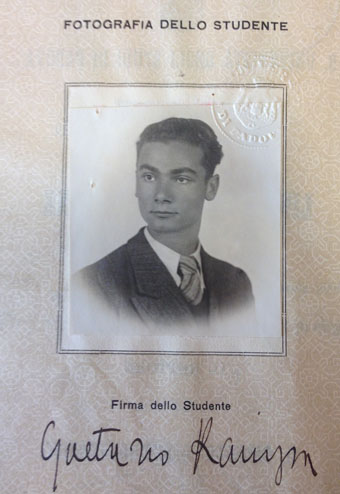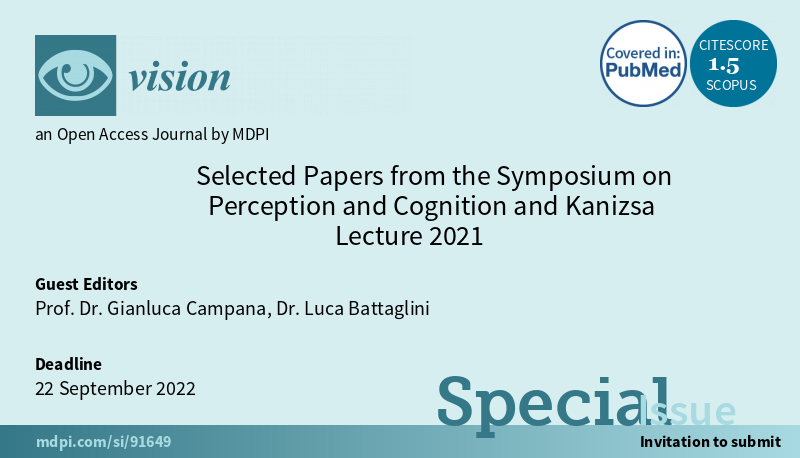Kanizsa Lecture
Welcome
[Jump to: Welcome * Kanizsa Lecture 2021 * Symposium 2021 * Past Lectures]
Gaetano Kanizsa is famous world-wide for his contribution to the study of perception and cognition. He graduated from the University of Padova in 1938 under the supervision of Cesare Musatti, and worked in Milan, Florence and Trieste. In addition to his academic production, he was also an artist (www.gaetanokanizsa.it/).
The Kanizsa Lecture is a public event traditionally organized by the University of Trieste. The first edition was in 1993, the year of Kanizsa's death.
The lecture is annual and is delivered by a distinguished scholar, active in the fields of perception and cognition.

Kanizsa as a student in Padova. He graduated in 1938.
Kanizsa Lecture 2021
[Jump to: Welcome * Kanizsa Lecture 2021 * Symposium 2021 * Past Lectures]
University of Padova
October 22 2021
Programme
The 29th Kanizsa Lecture was delivered by Professor Michael Herzog. The event was open to the public. A limited number of guests attended the lecture in the Sala Archivio Antico, Palazzo Bo, Padova, while the event was streamed live on the official channel of the University of Padova and on youtube.
The lecture was followed by a reception in the Sala delle Colonne.
The same day as the Kanizsa lecture, as it is tradition, there was a symposium on Perception and Cognition. The event was free, and it included a series of talks selected after peer review.
These events are part of the celebrations organised as the University of Padova approaches its 800 anniversary, in the year 2022 (Ottocentenario").
We thank for their support the University of Padova, the Department of General Psychology, the Associazione Italiana di Psicologia, and the University of Trieste

29th Kanizsa Lecture
Prof Michael Herzog
"THE IRREDUCIBILITY OF VISION: GESTALT, CROWDING AND THE FUNDAMENTALS OF VISION"
Michael Herzog is Professor of psychophysics in the Brain Mind Institute of the School of Life Sciences at EPFL (École Polytechnique Fédérale de Lausanne) and head of the Laboratory of Psychophysics.
He has studied at the University of Erlangen, University of Tübingen, Caltech and MIT. His work on visual perception is multidisciplinary and it draws on biology, neurosciences, mathematics, and philosophy. In his laboratory, Herzog is investigating visual perception using psychophysical methods, electrophysiology, and mathematical modeling.
Topics include feature integration, perceptual learning, and crowding. Herzog work is also rooted in the Gestalt tradition with a strong attention to the phenomenology of visual perception.
www.epfl.ch/labs/lpsy/team/herzog/
The organising committee:
Marco Bertamini, Paolo Bernardis, Luca Battaglini, Mario Bonato, Gianluca Campana, Carlo Fantoni, Walter Gerbino, Massimo Grassi
Video recording: http://youtu.be/rpUoeLD85GE
Symposium 2021
[Jump to: Welcome * Kanizsa Lecture 2021 * Symposium 2021 * Past Lectures]
The Symposium on Perception and Cognition took place on Friday October 22, 2021. Traditionally, the Symposium is open to all perspectives and approaches, has no registration fee, and runs on an informal, relaxed pace.
You can download the programme: Programme
- 9:30.
Bertamini, M., Bernardis P., Campana, G.
Welcome - 9:50.
Contemori, G., Saccani, M.S. & Bonato, M.
Multitasking Effects on Perception and Memory in Elderly Adults - 10:10.
Bertamini, M., Makin, A.D.J. & Rampone, G.
Symmetry Perception from Spatiotemporal Integration, an EEG Study - 10:30.
Uccelli, S. & Bruno, N.
The Uznadze Illusion Reveals a Two-Pronged Dissociation Between Perception and Action - 10:50.
Gervain, J., Nallet, C., Vallortigara, G., Zanon, M., Lemaire, B., Caramellino, R., Piasini, E., Buccellato, A., Carboncino, A., Balasubramanian, V., Zoccolan, D.
The Efficient Coding of Visual Textures in Rats, Chicks and Human Infants - 11:50.
Cuturi. L.
Perceptual Biases Reveal the Role of Multisensory Interactions in Vestibular Perception - 12:10.
Loconsole, M. & Regolin, L.
A Perceptual Mechanism to Discriminate Prime Numbers in the Baby Chick (Gallus gallus) - 12:30.
Gatto, E., Guan, C., Agrillo, C., Cutini, S., Chittka, L., Petrazzini, E.M.P.
Numerosity Illusion in Bumblebees - 12:50.
Ronconi, L.
Alpha and Beta Rhythms Subserve Spatio-Temporal Integration in Perception - 14:30.
Makin, A.J.D.
New Insights into Symmetry Perception from a Large Public EEG Database. - 14:50.
Donato, R., Cavallin, G., Pavan, A., Betteto, L., Nucci, M., Ballan, L., Campana, G.
Mechanisms Underlying Real Motion Processing and Form-Motion Integration Assessed with Perceptual Learning. - 15:10.
Bruno, N.
Weber in Perception and Action: A New Interpretation. - 15:30.
Romei, V.
Boosting Frontoparietal Alpha-Synchronization Facilitates the Suppression of Irrelevant Information in a Working Memory Task. - 15:50.
Vicentin, S., Cona, G., Arcara, G., & Bisiacchi, P.
Different Impacts of Focus of Attention on Visual and Auditory Processing.
Finally, this year the symposium is linked to a Special issue in the journal Vision.
www.mdpi.com/journal/vision/special_issues/Kanizsa_Lecture_2021

Past lectures
[Jump to: Welcome * Kanizsa Lecture 2021 * Symposium 2021 * Past Lectures]
The past lectures have been organised by the University of Trieste. The organisers are Paolo Bernardis, Carlo Fantoni and Walter Gerbino. THe 2015 lecture is the exception and it was held at the University of Parma
- 1993 IRVIN ROCK The Legacy of Gestalt Psychology
- 1994 KEN NAKAYAMA Visual Surface Representation: A Missing Link Between Early and High Level Vision
- 1995 VILAYANUR S. RAMACHANDRAN A Critique of Pure Vision
- 1996 PHILIP N. JOHNSON-LAIRD Illusions in Reasoning
- 1997 ALAN GILCHRIST Visual Structure and Surface Color
- 1998 HEINRICH H. BÜLTHOFF Perception and Action: Controlling the Loop Using Virtual Realities
- 1999 RICHARD L. GREGORY The Phenomenal Science and Art of Perception
- 2000 STEPHEN E. PALMER Rethinking Perceptual Organization
- 2001 ENNIO MINGOLLA The Units of Vision
- 2002 PATRICK CAVANAGH Art and the Language of Vision
- 2003 MICHAEL KUBOVY Regular Patterns in Visual, Auditory and Aesthetic Perception
- 2004 ELIZABETH S. SPELKE What Makes Humans Smart
- 2005 ALAN M. LESLIE How the Brain Thinks About the Mind
- 2006 MELVYN A. GOODALE Visual Duplicity: Action without Perception in the Human Visual System
- 2007 LOTHAR SPILLMANN Perceptual Research for Beginners. A Journey Through the Vision Sciences
- 2008 ANNE CUTLER Native Listening
- 2009 JAN J. KOENDERINK Mind into Space
- 2010 JOHAN WAGEMANS The Kanizsa Triangle as a Cornerstone of Vision Science
- 2011 JAMES R. POMERANTZ The Perception of Visual Configurations and Their Parts: A Theory of Basic Gestalts
- 2012 ALFONSO CARAMAZZA Objects, Actions, Words, and Brain
- 2013 DEJAN TODOROVIĆ Reality and Illusions: Effects of Context and Vantage Point in Visual Perception [ video ]
- 2014 BARBARA GILLAM Grouping and Occlusion in Perception and Art [ video ]
- 2015 VITTORIO GALLESE The multimodal nature of visual perception: Facts and speculations
- 2016 W TECUMSEH FITCH The Biology of Speech - 50 Years of Progress
- 2017 TIM SHALLICE How disorders of supervisory processing relate to the overall organisation of mind
- 2018 WALTER GERBINO Perception and Past Experience 50 Years After Kanizsa's (Im)possible Experiment [ video ]
- 2019 ROBERTO CASATI Shadows in vision
- 2020 GIORGIO VALLORTIGARA Of chicks and babies. How to build a social brain. [ video ]
- 2021 MICHAEL HERZOG The Irreducibility of Vision: Gestalt, Crowding and the Fundamentals of Vision. [ video ]
- 2022 CHARLES SPENCE, On Crossmodal and Multisensory Gestalts: Evidence & Application. [ video ]
- 2023 PHIL KELMANN, From Fragments to Objects: Understanding Visual Completion in Object Perception. [ video ]
- 2024 ACHILLE VARZI, On owning a border. [ video ]
- 2025 VEBJØRN EKROLL, How do magic tricks really work? From basic research on the phenomenology of perception to applications in road safety. [ video ]





